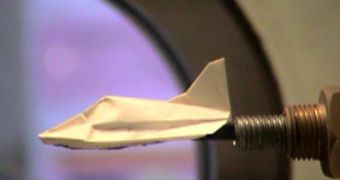If you are wondering about how the next generation of space shuttles or sub-orbital planes would be like, then you should probably take a look at this paper beauty. Although it doesn't seem quite ready for orbital flying, this paper model could probably be launched from the International Space Station, fly all the way through Earth's atmosphere, and land safely on the surface. The origami plane was tested last week in the wind tunnel, at speeds of about Mach 7, when it reached a surface temperature of 200 degrees Celsius.
The paper model planet has been designed by a Japanese engineering professor and build by an origami master. It might not seem like much, but in fact models are just the first stage in the development of new spacecrafts. Previously, the team worked with the industrial giant Suzuki, project that resulted in the construction of a 3 meter long paper plane with a shape very similar to that of NASA's space shuttle, plane that was dropped from a mountain peak.
Similarly to the U.S. space shuttle design, the front part of the origami plane is rounded in order to minimize the air drag and the produced heat, which could easily destroy the paper model. To protect it even further, the 20 centimeters airplane received a silicon coat chemically impregnated in the paper structure which ultimately increased its heat resistance.
Most objects falling through the Earth's atmosphere experience extremely high speeds which generate high quantities of heat. However, even if the origami plane would be released from the ISS at speeds of Mach 20, the ratio between its surface area and weight would quickly decrease it to more reasonable speeds, protecting it from the fearsome blazes during the initial fall through the top layers of the atmosphere.
Nevertheless, the plane has small chances to be ever launched from the ISS. And even if it is, it will probably behave in unpredictable ways, meaning it could land almost anywhere on the Earth's surface and we will never know what actually happens to it. Tracking it with the radar is next to impossible, due to the relative low surface area and the fact that paper is invisible in the radio spectrum. A much better idea would be to plant a tracking device.

 14 DAY TRIAL //
14 DAY TRIAL //